The pandemic caused by the coronavirus forced us to make changes in our EM promotion activities. Various lectures and conferences have changed from in-person format to using Zoom, which has significantly reduced costs and time, but also gave us the opportunity to engage in fundamental changes.
EM can be quite versatile if its quantum properties are utilized, but common sense persists in believing that the “all-powerful” does not exist” and is a fake idea.
EM is now used all over the world in the fields of agriculture and the environment. The unimaginable EM bashing of the past, which insisted that EM is “pseudo-science,” has disappeared.
The key to taking advantage of EM’s quantum mechanical versatility is to use it in a way that improves its functionality throughout the year. In other words, we must not only provide lectures and training sessions, but also provide on-site demonstrations of its use.
The creation of the Universal Village model being promoted by the EM Research Organization and United Networks for Earth Environment (U-net), a nonprofit organization, is an advanced development of EM activities. This is based on the vital need for a Copernican-level reform, a change from the conventional use of EM in conventional farming methods to a method of farming that is adapted to the versatility of EM.
The most important thing is that the soil microbiota must be EM-enhanced and managed in a stable manner over a period of time. To do this, spread a thin, wider layer of organic matter such as weeds, leaves, kitchen waste, etc., over the soil, and then spray activated EM liquid diluted with water to 1:50-100 and apply it on top until the entire area is moistened. At the same time, continue no-till continuous cultivation. Even in cold winters you still can improve the microbial flora by applying 50 to 100 kg of salt and 10 to 500 liters of activated EM liquid per 10 ares before the snow piles up.
At Blue Sky Palace, as I previously introduced (see No. 182) I have produced perennial grass biomass with a barrier function and I am continuously growing tomatoes, cucumbers, eggplants, etc., and am committed to no-tillage. Potatoes and other crops can be cultivated by simply applying EM Bokashi and activated EM liquid in the furrows and putting potatoes in, then covering them with about 5 cm of weeds.
Photo 1 shows the tomatoes introduced in article No. 189. I have already harvested over 500 of them, and they have grown into a hedge of tomatoes.
Lettuce is planted at the base of tomato plants, and as shown in Photo 3, old leaves are removed and spread on the surface as shown in Photo 3.
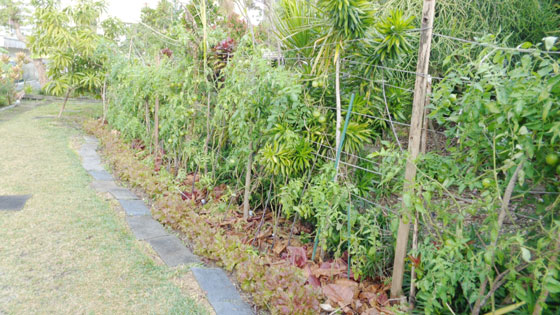
Photo 1: Overall view of EM natural cultivation
On the far left is leaf lettuce, and the inside is covered with fallen leaves.
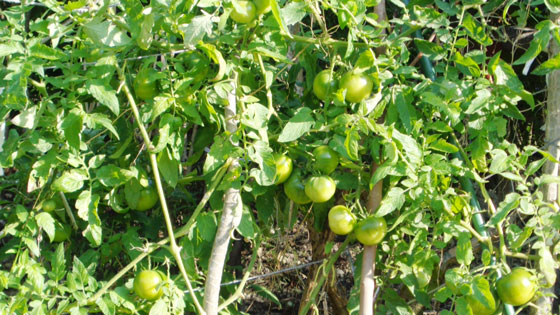
Photo 2: Fruiting section of tomatoes
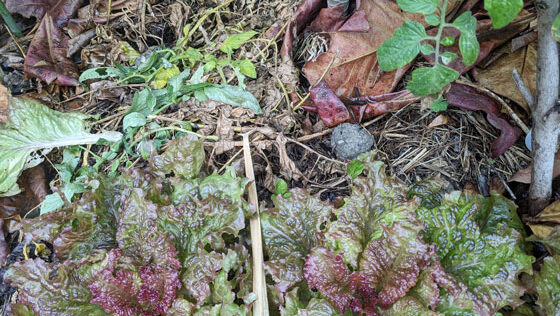
Photo 3: Lettuce planted at the base of the tomato plant in Photo 1. The one placed in the center of the image is a salt ball made with half EM incinerated ash and half salt.
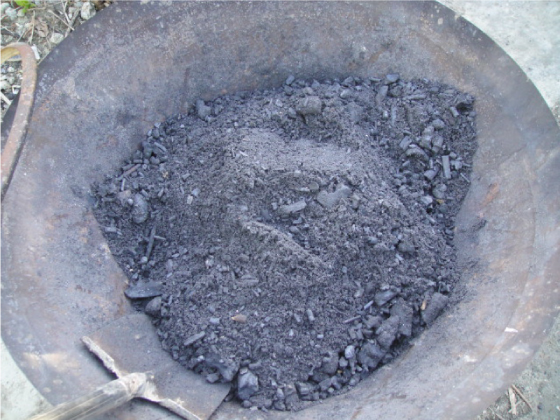
Photo 4: EM rectified ash. From the former Web Ecopure No. 138.
The ash is mixed with salt, and the moisture is adjusted with activated EM liquid to make balls. If you do not have rectified ash, use EM rectified charcoal (How to make rectified charcoal using a smokeless carbonizer) or EM Gravitron charcoal as a substitute.
Reference: Former Web Ecopure (now “New Living with the Dream”): Application of the Diversity of Charcoal (No. 138) and Application of the Diversity of Charcoal 2 (No. 139).
If you apply this ash regularly, it will become like the perennials seen in Photo 5.
Photo 6: The center row in Photo 6 is an experiment in self-seeding potatoes. At the same time as planting, I applied a 5-6 cm layer of weed mulch.
Photo 7 shows the condition after one month. This method can be applied as an intercrop after harvesting sugarcane, and as with the cultivating method of simply putting potatoes on the soil with covering mulch without digging holes, you can harvest them without digging them.
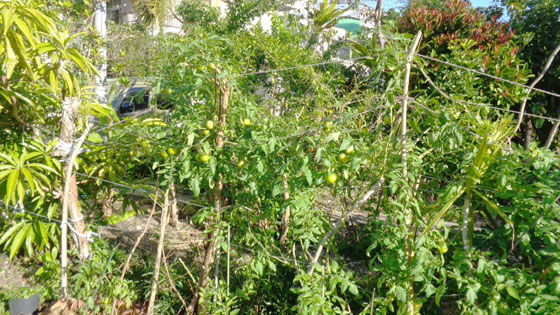
Photo 5
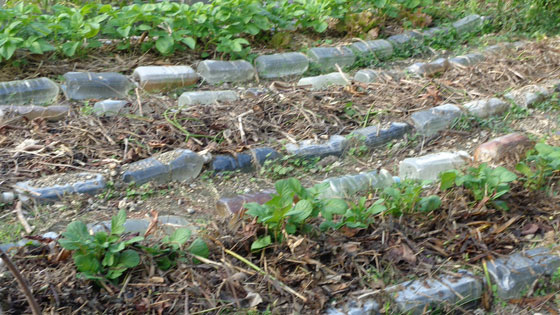
Photo 6
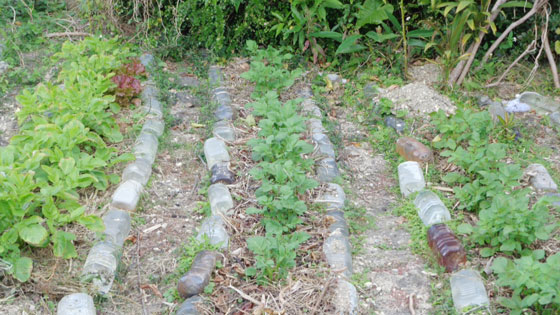
Photo 7
I have already reported on Typhoon No. 6 and how the all the plants recovered very quickly afterwards, and there are many realities that, based on past experience, should be impossible (since it usually takes 2 to 3 years for recovery), and here I would like to introduce some of them. As always, a variety of stray birds are coming to Okinawa this winter. Groups of cormorants are also gradually growing larger, proof of abundant food sources here.
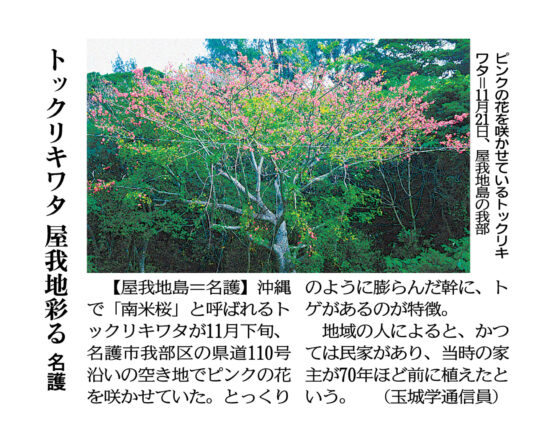
Photo: Silk floss tree blooming with pink flowers November 21, in Gabu-Ward, Yagaji Island
Okinawa Times, December 21, 2023
Yagaji Island, Naha City: In late November the pink flowers of the silk floss tree, called the “South American cherry tree” in Okinawa, was blooming in a vacant lot along Prefectural Route 110 in Gabe Ward, Nago City.
The tree is characterized by thorns and a distinctive trunk, which bulges out like a sake server bottle. According to a local resident, there used to be a private house there, and the owner of the house planted the tree about seventy years ago.
(Reported by Manabu Tamaki)
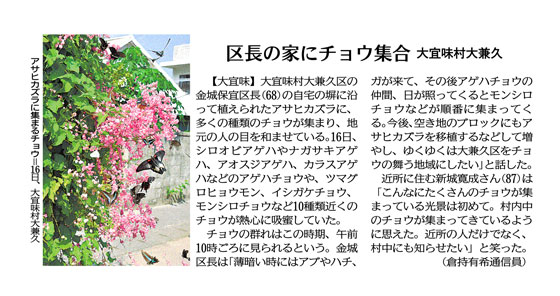
Photo: Butterflies gather on Asahikazura, Mexican creeper October 16, in Ogane Ward, Ogimi Village
Okinawa Times, October 24, 2023
Many types of butterflies are gathering on the Asahikazura, Mexican Creeper, planted along the fence of the house of Yasunori Kinjo, 68, the head of Ogane Ward of Ogimi Village, Okinawa Prefecture, and this has attrcated the attention of local people. On the 16th, nearly ten types of butterflies were eager sucking nectar. These include swallowtail butterflies such as the White-throated Swallowtail, the long-tailed Swallowtail, the Blue-throated Swallowtail, and the Crow Swallowtail, as well as the Black-bellied Fritillary Butterfly, the Cyrestis thyodamas, and the Monarch Butterfly. At this time of year the flocks of butterflies can be seen around 10 am. Mr. Kinjo said, “When it’s dark, horseflies, bees, and moths come, followed by swallowtail butterflies, and when the sun shines, cabbage butterflies and other butterflies gather in turn. In the future, I hope to increase the number of these butterflies by transplanting Mexican Creeper to blocks of vacant land, and eventually turn Ogane Ward into an area where butterflies can be seen fluttering together.” Mr. Hironari Shinjo, 87, who lives nearby, said, “I have never seen so many butterflies gathered in one place. It seems as if butterflies from all over the village were gathering here. I want to let not only my neighbors but the whole village know about it,” he laughed. (Reported by Yuki Kuramochi)
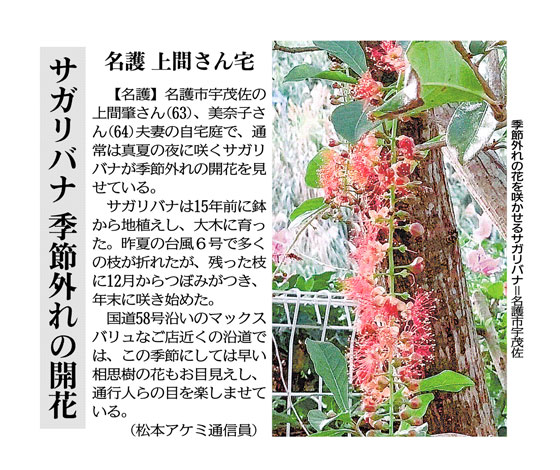
Photo: Sagaribana, Barringtonia racemosa, blooming out of season in Umusa, Nago City
Okinawa Times, January 16, 2024
In the garden of Mr. Hajime Uema, 63, and his wife Minako, 64, in Umusa, Nago City, the Sagaribana, which usually blooms at night in mid-summer, is blooming out of season. The Sagaribana was transplanted from a pot fifteen years ago and has grown into a large tree. Many of the branches broke during Typhoon No. 6 last summer, but buds started forming on the remaining branches in December, and they began blooming at the end of the year. Along National Route 58 near the MaxValu Nago store, the flowers of the Acacia tree also made an early appearance for the season, pleasing the eyes of passerby.
(Reported by Akemi Matsumoto)
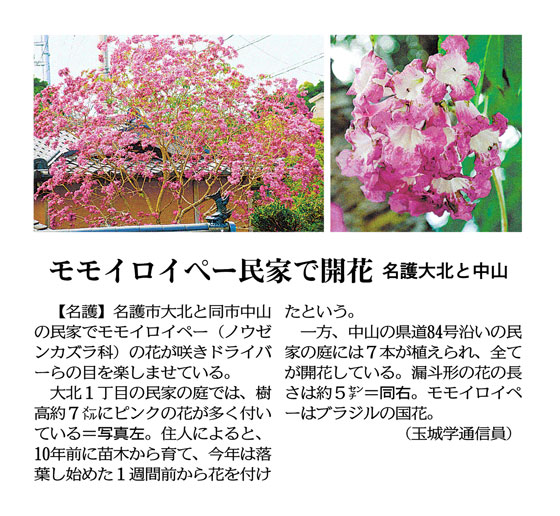
Okinawa Times, January 14, 2024
Pink Ipe flowers (Bignoniaceae) are blooming at private residences in Okita and Nakayama, Nago City, and delighting the eyes of drivers. In the garden of a home in Okita 1-chome, a tree about seven meters tall is full of pink flowers. (Photo left). According to the resident, he grew the tree from a sapling ten years ago, and this year it started blooming a week before the leaves began to fall. Meanwhile, seven trees planted in the garden of a home along Prefectural Route 84 in Nakayama are all in full bloom now. The funnel-shaped flowers are about 5 cm long (Photo on the right). Pink Ipe is the national flower of Brazil.
(Reported by Manabu Tamaki)
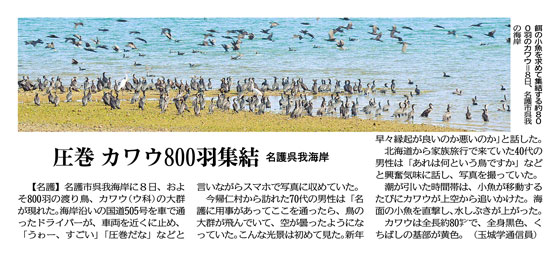
Photo: About 800 cormorants gather on the beach at Goga, Nago City, on the 8th, in search of small fish for food.
Okinawa Times, January 13, 2024
On the 8th, a large flock of about 800 migratory birds, cormorants (family Cormorantidae), appeared on Goga Beach in Nago City. A driver passing by on National Route 505 along the coast stopped his car and took pictures with his cell phone. “Wow, this is amazing!” was his reaction.
A man in his 70s who visited Nakijin Village said, “I had an errand in Nago and was passing by here when I saw a large flock of birds flying. There were so many it was like the sky had clouded over. I had never seen such a sight before. I don’t know whether this is a good luck signs or bad luck for the New Year.”
A man in his 40s who was on a family trip from Hokkaido excitedly asked, “What kind of bird is that?” and kept taking pictures.
When the tide was low, the cormorants dove from the sky to chase the small fish as they moved. They hit the small fish on the surface of the sea, sending up splashes. The cormorants are approximately 80 centimeters long, all black, with yellow at the base of their beaks.
(Reported by Manabu Tamaki)
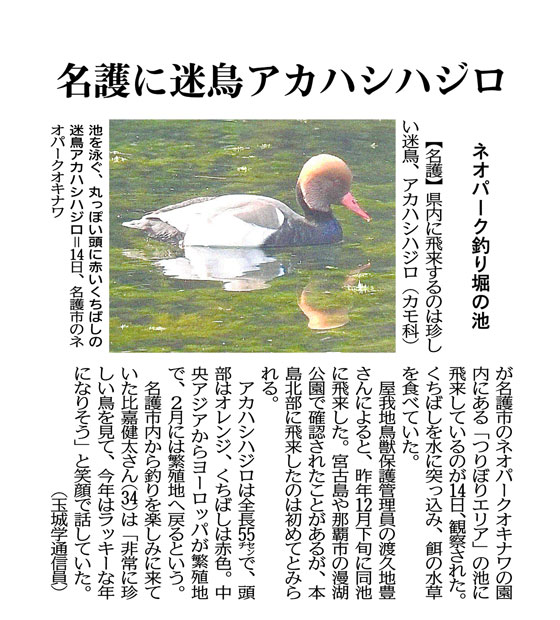
Photo: A stray bird, red-crested pochard with a round head and red beak swims in a pond at Neo Park Okinawa in Nago City on March 14th.
Okinawa Times, January 17, 2024
On the 14th, a red-crested pochard (family Anatidae), a bird that rarely strays into Okinawa Prefecture, was observed flying into a fishing pond at the “Neo Park Okinawa” in Nago City. It was sticking its beak in the water, feeding on aquatic plants.
According to Mr. Yutaka Toguchi, a Yagaji wildlife conservation manager, the bird flew to the pond late last December. It is believed that this is the first time it has flown to the northern part of the main island, although it has been observed in the past on Miyako Island and at Manko Park in Naha City.
Red-crested pochards are 55 centimeters in length with an orange head and red beak. Their breeding grounds range from Central Asia to Europe, and they normally return to their breeding grounds in February.
Mr. Kenta Higa, 34, who came from Nago City to enjoy fishing, was happy to see it. “I saw a very rare bird,” he said, “so I think this will be my lucky year.”
(Reported by Manabu Tamaki)
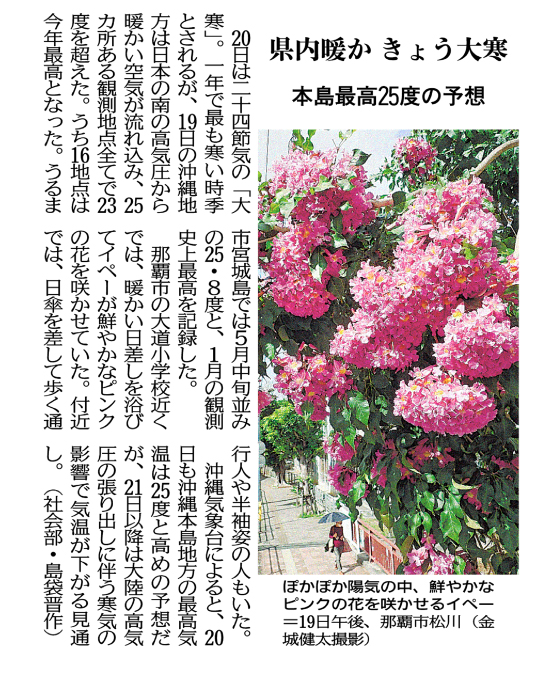
Bright pink flowers bloom in the warm weather in Matsugawa, Naha City on the afternoon of the 19th. (Photo by Kenta Kinjo)
Expected high of 25 degrees Celsius on the main island
Okinawa Times, January 20, 2024
The 20th is the “Daikan,” which is the coldest time of the year according to the 24 solar terms, but today, on the 19th, warm air from a high-pressure system to the south of Japan flowed into the Okinawa area, and the temperature exceeded 23 degrees Celsius at all 25 observation sites. Sixteen of these locations recorded their highest temperatures of this year. Miyagi Island in Uruma City recorded the highest January temperature ever recorded at 25.8 degrees, about the same as mid-May.
Near Daido Elementary School in Naha City, bright pink flowers were blooming on Ipe trees in the warm sunshine. Nearby, passersby were walking with parasols and some people were wearing short sleeves. According to the Okinawa Meteorological Observatory, the highest temperature in the main island of Okinawa is expected to reach 25 degrees on the 20th, but then temperatures will drop from the 21st onwards due to the effects of cold air caused by an extended high pressure system on the Asian mainland.
(Shinsaku Shimabukuro, Social Affairs Department)
Read the original Japanese message at the link below.
2024.4.1 Updated.